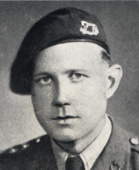 Captain Philip Hugh Pinckney
Captain Philip Hugh Pinckney
Male, Person Number500, b. 7 April 1915, d. 7 September 1943
| Relationships | 2nd cousin 1 time removed of George Pinckney 1st cousin 4 times removed of Aaron Pinckney 4th great-nephew of Robert Pinckney 11th great-grandson of Thomas Pynkeney 23rd great-grandson of Arnulph Picquigny 7th great-nephew of Roger Pinckney I 1st cousin 8 times removed of Philip Pinckney |
| Father | John Robert Hugh Pinckney CBE b. 11 May 1876, d. 20 Feb 1964 | |
| Mother | Winifred Nicola Hill b. 13 Jan 1880, d. 12 Apr 1976 |
Birth, Marriages and Death | ||
| Birth* | 7 Apr 1915 | Captain Philip Hugh Pinckney was born on 7 Apr 1915 at Hidden Cottage, Hungerford, England, ; apr-may-jun 2c 493.1 |
| He was the son of John Robert Hugh Pinckney CBE and Winifred Nicola Hill. | ||
| Death* | 7 Sep 1943 | Captain Philip Hugh Pinckney died on 7 Sep 1943 at Baigno, Italy, , at age 28; On 10th July 1943 the S.A.S. went into action in Sicily ahead of the invading armies of the Allies. For fifteen days they marauded behind the German lines. On the German withdrawal to the Italian mainland, the S.A.S. went back to Africa to refit themselves for the next stage. This took the form of landing in Northern Italy to disrupt communications. In September 1943, Philip and six of his men were dropped by parachute near Bologna. Philip was loaded up with several million lira which he was to deliver to the partisans assisting us in German-held territory. He had at this time a cracked spine which was being treated, but he insisted on going with his men, and overruled the doctor who tried to stop him, and who in the end had to apply freezing mixture to deaden the pain. On the night of 7th September they flew out. Lance-Sergeant Stokes, writing afterwards, described the scene: He jumped first and I second. I heard his old familiar bellow and saw him vanish through the aperture and I followed hard on his heels. It was a nice night and I could see everyone clearly - just before we landed I swung out of line and started to drift away and the Captain yelled to me: 'Watch your drift, Stokes, watch your drift.' I hollered back: 'O.K., sir.' I then saw him half wave his arm in acknowledgement. That's the last I saw of him as my drift continued, and a few seconds later I landed smack into a house in an Eyetie village. We all got together except for the Captain, and against orders spent an hour and a half looking for him.... There is no doubt at all in my mind that his back gave way when he landed. Thus injured, Philip didn't stand a chance. He was captured, so local sources stated, and shot, in spite of his uniform, the same day by Italian Carabinieri, and buried at Baigno. On 22nd February 1945 he was reburied in the British Military Cemetery at Florence. All his men returned safely to base after six weeks behind the enemy lines. |
Other Information | ||
| Reference* | Reference: Hungerford Virtual Museum. | |
| Occupation | between 1939 and 1940 | Captain Philip Hugh Pinckney was in the Berkshire Imperial Yeomanry between 1939 and 1940. |
| Occupation | between 1940 and Mar 1943 | He was a Lieutenant in No 12 Commando between 1940 and Mar 1943. |
| Event-Misc* | after 1943 | He was In Memoriam Memorial after 1943 at St Peter's Church, Charlton St Peter, England, . |
| Occupation* | between Mar 1943 and 7 Sep 1943 | He was a Captain in the Royal Artilery, Special Air Service between Mar 1943 and 7 Sep 1943. |
| Anecdote* | 1982 | Extract from "The Special Air Service" by Philip Warner Philip Pinckney was posted to 2 S.A.S. in the summer of 1943. After serving in Sicily he was parachuted on to the Brenner Pass. There, after he had blown up a railway tunnel, he was captured and shot by the Gestapo. His execution was, of course, a crime under International Law. Just as endurance walks of Keith, Sillits, Langton and others had established that an S.A.S. man can (probably) walk his way from anywhere to anywhere, so Pinckney established the fact that an S.A.S. man could live on anything almost anywhere. He was a food expert and delighted in collecting slugs, snails, grasshoppers and strange unhealthy looking leaves and insects, which many even would dislike to touch, let alone eat. Few commanders have ever inspired such awe. Terror in their men, who never knew what they might be required to swallow next. However, not all Pinckney's diets were bizarre and he chose a blend of rations which would be reasonably satisfactory in any area. This eventually became the standard S.A.S. operation ration. |
| Anecdote | 2008 | Extracts from "The Memories of Sgt John Huntington" available at http://www.commandoveterans.org The other section was commanded by the best Officer, man and gentleman who I have ever met in my life, no matter where I went he was Lt. Philip Pinckney. Lt. P H Pinckney took command of ‘E’ Troop as Capt. He was the finest officer gentleman and leader I have ever come across during my lifetime. He once refused to be decorated unless every member of the troop on that certain operation received the same medal. Needless to say his request was turned down. Capt. Pinckney never received his medal. He was killed (murdered) on an SAS operation in Bologna in Northern Italy in 1944. |
Citations
- [S7] Birth Registration.
| Last Edited | 8 Apr 2022 |








